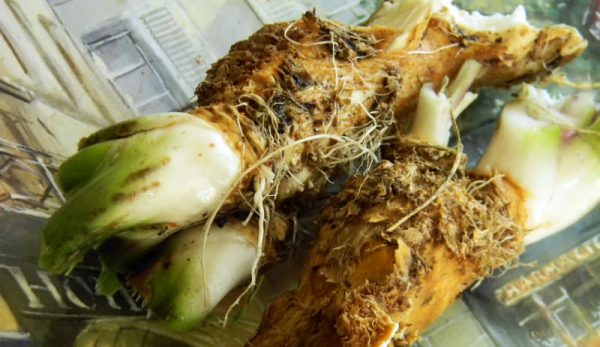
I feel like I am in a special kind of denial. While watching the leaves begin to drop, I’m confused why this is happening in the middle of summer. I have clearly lost some time and am having difficulty accepting that as I write this in these first days of fall.
With the leaves dropping, I know that my horseradish (Armoracia rusticana) will soon die back and return its fierce energy to its roots. With the first of the cold snaps these roots regain their firmness and are ready to dig.
I begin my love affair with this crop when its leaves begin in the spring. I greedily eye my horseradish bed, awaiting the time when I can dig their delicious roots for fresh sauce. Throughout the growing season, I pick the small fresh leaves, snacking on them as I go by or adding them to salads for their radishy excitement and stimulation. The leaves are very mild in comparison to what I can get if my patience holds out until fall.
Manage the Spread
If you do not have horseradish in your garden, I’d like to make you into a covert. Some dislike its tendency to spread, but how can it spread when you’re eating it with abandon? In the spring, you can have a root or two shipped to you through a garden catalog or pick up a pot of the plant at your local nursery. To manage its spread, you’ll have to dig up areas encroaching on other flower beds. In short order, you’ll have a large patch to share with friends and family.
We planted our horseradish plants in a raised bed with wooden sides. They stay relatively contained, though a few have hopped their boundaries. This plant relishes having its roots ravished. They thrive on being managed. As you pull large roots out of the soil, small rootlets remain behind to make new plants. As you harvest and thin, the plants become more robust and more healthy, spreading out into the space their neighbor once occupied. In short, they’re extraordinarily hearty and will provide for your family for years if you do your part in eating them.
Why Use It?
Fresh horseradish root is extremely aromatic and very healthy. I invariably pick a day that is too cold to grind the roots outside. My parents click their tongues and shake their heads, as they long ago learned the wisdom of using their Vita-Mix outside on a windy day. I, however, like to grind it when someone in my house is suffering from sinus congestion. This is a two-birds-with-one-stone moment, as the very pungent oils that are released during grinding can open up the sinus passages in a heartbeat. I usually keep a box of tissues close at hand for this reason.
Fresh horseradish sauce entails a splash of white vinegar and a dollop of honey. This is perfect as a pork marinade, but also a supplement that can be eaten right out of the jar.
Horseradish can be used similarly to a mustard or ginger poultice to break up congestion. Using a cloth barrier between it and your skin, spread the ground horseradish over the area of congestion to stimulate things like a sluggish digestive, circulatory, immune or reproductive system. You might take a tablespoon of horseradish before eating to encourage the gallbladder to digest the fats in your meal more efficiently. It has also been found to be effective as a topical poultice for arthritic joints.
If you ask my family, I need no further encouragement to grow and eat horseradish. It is a health supplement, as well as a beautiful and rewarding plant to grow, and I think no family should be without it.
Cook up fresh horseradish in these recipes:




